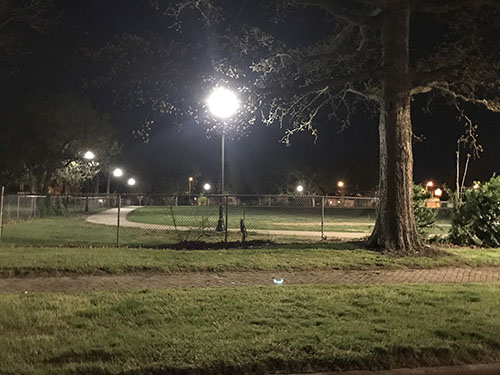Four years ago, new lights flickered to life at one of the oldest parks in the city, Lafayette Park. Funded by a grant through the City of Springfield’s Neighborhood Works program, through an application from the Woodland Heights Neighborhood Association, the lights brightened up the tennis court and the shady east side of the park..
But the west side of the park, an open field with a walking track, remained unlit. And after dark, neighbors started noticing some questionable activity.
“People were parking along the border of the park at night, and if you walked over in the morning, you’d find trash, you’d find evidence of drug use, and there were some fights,” said Chance Parish, a neighbor of Lafayette Park. “It made the area seem unsafe. Neighbors were afraid, even people who had lived here for years.”
After several appearances by law enforcement, neighbors of Lafayette Park proposed a more lasting solution: #LightLafayette. It started with sharing photos and video on social media, but quickly became a neighborhood conversation, ultimately resulting in a partnership between several agencies that shared a vision for expanding lighting at Lafayette Park.
“The story here is collaboration,” said former Zone 1 City Councilwoman Phyllis Ferguson, also a neighbor of the park. “There was a problem in the neighborhood, and a collaboration between the residents and the Woodland Heights Neighborhood Association, the parks department, the City and City Utilities fixed the problem. And it’s a beautiful fix!”
The neighborhood presented the proposal to the City of Springfield. Ferguson, serving as mayor pro tem at the time, helped expedite the City’s response, bringing together City Utilities of Springfield and the Springfield-Greene County Park Board. City Utilities responded quickly, installing new street lights on the park’s perimeter.
The Park Board priced and later installed decorative park lighting around the walking track, matching the fixtures on the east side. The City of Springfield and Ferguson’s City Council “pothole fund” helped cover the costs. The Park Board also repaired some lights from the earlier installation, and park rangers stepped up patrols.
Almost immediately, neighbors said, Lafayette Park felt safer.
“It is amazing how much the lights have helped,” said Parish. “There are people in the park from daylight to dark. It’s totally different than when we moved in two years ago.”
Ferguson said the lesson learned here is that when neighborhoods have an issue needing attention, they need to speak up.
“If you have a neighborhood issue, talk with your neighborhood association, talk to the City about what your need is, and help work out a solution,” said Ferguson. “Your voice will be heard, but you have to speak. The City is not always going to know how big the problem is, or what needs to be fixed. The neighbors know that better than anyone, so it takes the neighborhood to help fix the problem.”
Parish said it was gratifying to see the power of neighborhood collaboration.
“It’s easy to feel alone, like you can’t reach out,” he said. “But the first thing to do is reach out and talk to your neighbors. Find the thing you need, make the case for it, and ask. It’s the smallest thing in the world, and most people don’t think that would work. But it worked for us.”


